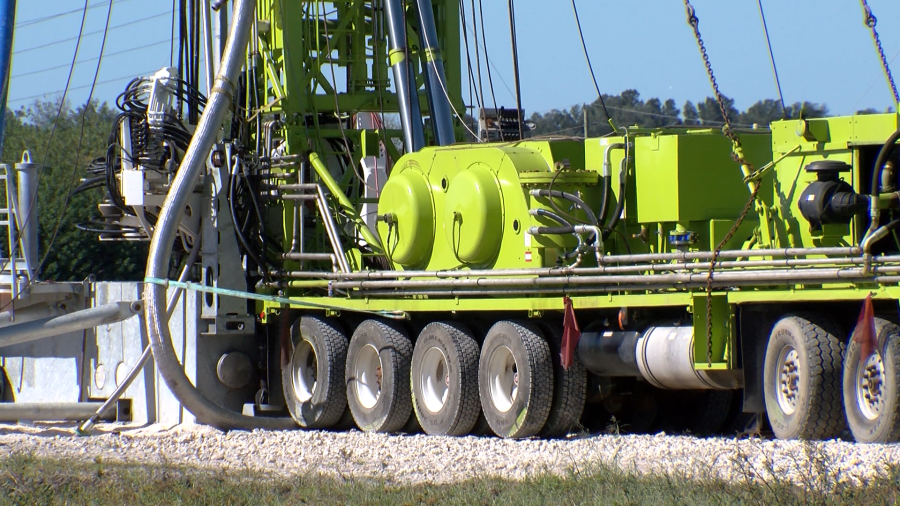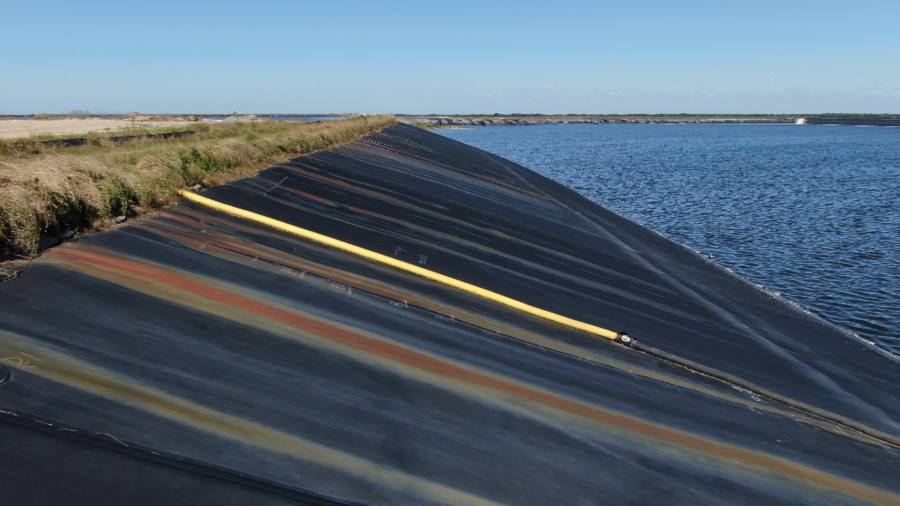MANATEE COUNTY, Fla. (WFLA) – The deadline to file petitions against a permit for what some consider a dangerous option to drain Piney Point came and went without any objectors, clearing a key hurdle for drilling to start for an injection well.
A March breach in the defunct facility’s southern fertilizer stack prompted the state to allow more than 200 million gallons of wastewater to be discharged into the bay last Spring.
State-contracted biologists have said there was no clear, scientific connection between the release and the summer’s red tide, but critics insist the nitrogen-rich water fueled the bloom.
Florida Department of Environmental Planning (FDEP) spokesperson Alexandra Kutchta said since no petitions were filed “the department may now proceed with final agency action on the permit.” The permit was officially approved Thursday morning.
More than 7,300 public comments about the permit submitted to the agency, according to a news release.
Lime-colored drilling rigs have been set up for weeks across the street from Piney Point. The fact the machinery was ready and paid for long before the ink on the paperwork was dry made some suspicious the process was “fixed.”

Mannasota-88 Chairman Glenn Compton said opponents did not have the money to fight what critics consider bad environmental protection laws.
“Manatee County understood that the laws were so weak they knew they would be issued a permit and there’d be very little chance that someone could challenge it,” Compton said. “The chances of winning in court would be slim.”
Court-approved Piney Point Receiver Herb Donica, who has been involved with Piney Point in various ways for two decades, said while he was against the deep well in the past, the science backs it up as the most effective way to safely drain the stacks.
“The water will be far beneath our drinking water, under the limestone,” Donica said. “It will eventually come out into the Gulf 10,000 years later cleaner than the drinking water we have now.”
Compton strongly disagrees, insisting reverse osmosis was a safer option.
“We already have some of the most polluted ground water in the country, but they wanted the fastest and cheapest solution,” Compton said. “There’s no economically feasible or environmentally sound way to close a phosphogypsum stack. There’s a price to be paid and in this case it’s the groundwater pollution that will take place.”
According to permit filings, the well would have a maximum injection rate of 2,813 gallons per minute. But according to Donica, it will still take several years to close and cap the eyesore followed by decades of monitoring the area.
Trucking away millions of gallons, evaporating jets misting more into the air and a pipeline to a treatment plant have drained nearly 10 million gallons since September. But the southern stack is still up by two million gallons since then.

Donica said he remains concerned about another breach and the goal is to drain two feet from the troubled southern stack by June at a cost of about $4 million dollars an inch.
“We need to relieve the pressure,” Donica said. “The hydraulic pressure on the sidewalls doesn’t go away and in the rainy season it’s going to get worse.”
Donica has said he expects the water injection process into the 3,300-foot deep well could start by June.
Jaclyn Lopez, the Florida director for the Center For Biological Diversity, said her organization also favored reverse osmosis over the deep well.
“We are hopeful Manatee County will not rush to push this toxic waste underground and instead will facilitate testing, treatment and safe disposal of all of the water and materials at Piney Point to ensure the public and environment are protected from its harm,” Lopez said.
Lopez said one potential reason for a lack of petitions is litigating this type of issue through the Florida Department of Administrative Hearings can be “prohibitively expensive.”
Donica said drilling could start as early as next week. Manatee County Administrator Scott Hopes said that “is quite possible.”
“I am confident they will be drilling before the end of the month,” Hopes said.
Compton made the ominous prediction Piney Point will not be the last phosphogypsum problem in the state.
“We should’ve taken a pause and looked at the other technologies and done it right because we’re going to see this happen again,” Compton said. “The taxpayers as well as the policy makers need to realize the true cost of phosphate mining and processing and Piney Point is just the tip of the iceberg of what we can expect.”
The goal for draining and capping Piney Point is the Fall of 2026, but that could change according to Donica who said the site will be monitored for about 50 years after it’s closed.
Compton’s Manasota-88 and Lopez’s Center for Biological Diversity are among five organizations that filed a lawsuit earlier this year against state regulators and Piney Point owner HRK Holdings, INC. over the deep well plan.
